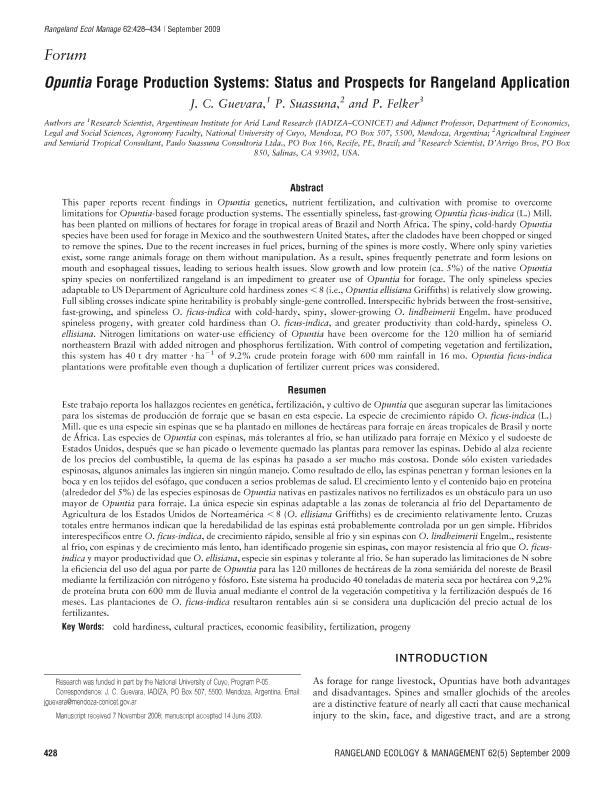Artículo
Opuntia forage production systems: Status and prospects for rangeland application
Fecha de publicación:
02/2009
Editorial:
Society for Range Management
Revista:
Rangeland Ecology and Management
ISSN:
1550-7424
Idioma:
Inglés
Tipo de recurso:
Artículo publicado
Clasificación temática:
Resumen
This paper reports recent findings in Opuntia genetics, nutrient fertilization, and cultivation with promise to overcome limitations for Opuntia-based forage production systems. The essentially spineless, fast-growing Opuntia ficus-indica (L.) Mill. has been planted on millions of hectares for forage in tropical areas of Brazil and North Africa. The spiny, cold-hardy Opuntia species have been used for forage in Mexico and the southwestern United States, after the cladodes have been chopped or singed to remove the spines. Due to the recent increases in fuel prices, burning of the spines is more costly. Where only spiny varieties exist, some range animals forage on them without manipulation. As a result, spines frequently penetrate and form lesions on mouth and esophageal tissues, leading to serious health issues. Slow growth and low protein (ca. 5%) of the native Opuntia spiny species on nonfertilized rangeland is an impediment to greater use of Opuntia for forage. The only spineless species adaptable to US Department of Agriculture cold hardiness zones < 8 (i.e., Opuntia ellisiana Griffiths) is relatively slow growing. Full sibling crosses indicate spine heritability is probably single-gene controlled. Interspecific hybrids between the frost-sensitive, fast-growing, and spineless O. ficus-indica with cold-hardy, spiny, slower-growing O. lindheimerii Engelm. have produced spineless progeny, with greater cold hardiness than O. ficus-indica, and greater productivity than cold-hardy, spineless O. ellisiana. Nitrogen limitations on water-use efficiency of Opuntia have been overcome for the 120 million ha of semiarid northeastern Brazil with added nitrogen and phosphorus fertilization. With control of competing vegetation and fertilization, this system has 40 t dry matter · ha-1 of 9.2% crude protein forage with 600 mm rainfall in 16 mo. Opuntia ficus-indica plantations were profitable even though a duplication of fertilizer current prices was considered.
Palabras clave:
COLD HARDINESS
,
CULTURAL PRACTICES
,
ECONOMIC FEASIBILITY
,
FERTILIZATION
,
PROGENY
Archivos asociados
Licencia
Identificadores
Colecciones
Articulos(IADIZA)
Articulos de INST. ARG DE INVEST. DE LAS ZONAS ARIDAS
Articulos de INST. ARG DE INVEST. DE LAS ZONAS ARIDAS
Citación
Guevara, Juan Carlos; Suassuna, Paulo; Felker, P.; Opuntia forage production systems: Status and prospects for rangeland application; Society for Range Management; Rangeland Ecology and Management; 62; 5; 2-2009; 428-434
Compartir
Altmétricas




